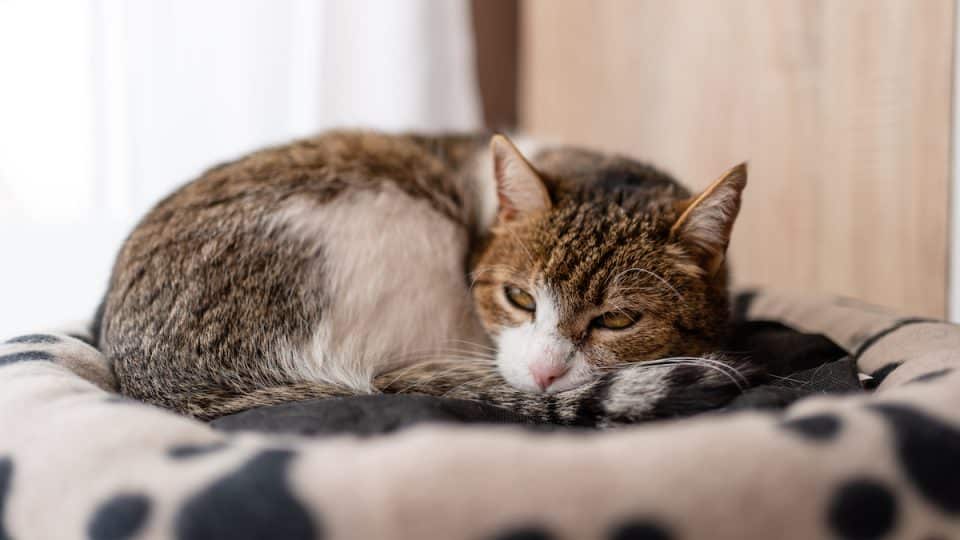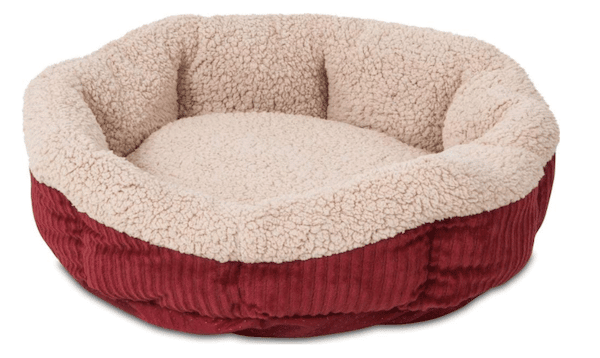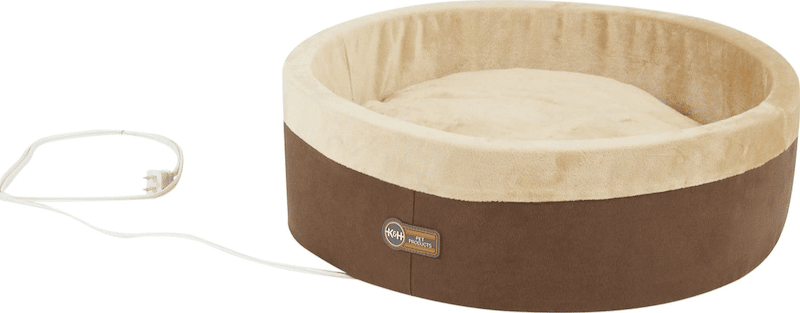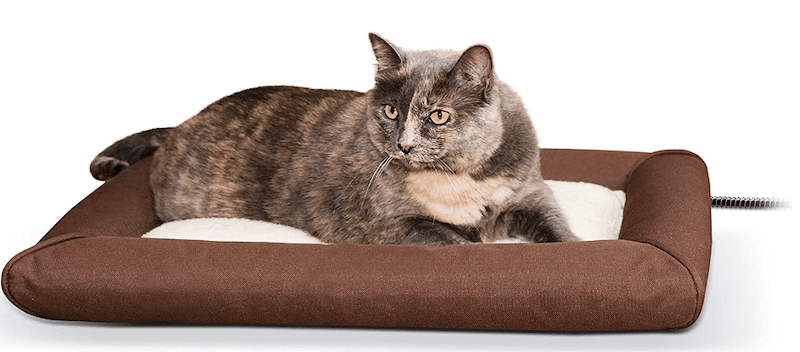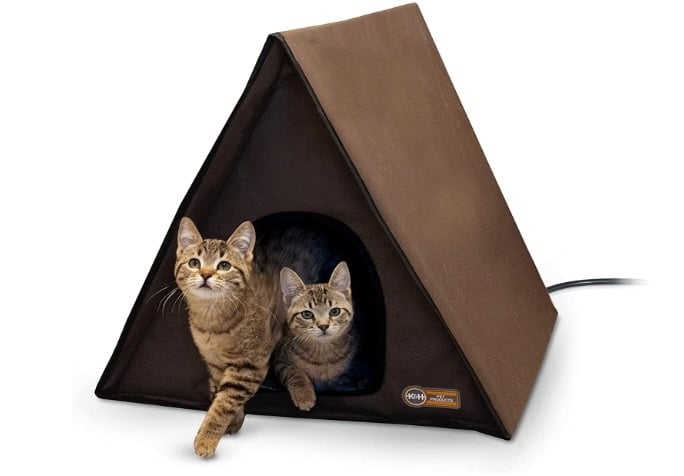- This post contains affiliate links. Read more here.
- Not a substitute for professional veterinary help.
Cats are natural heat seekers—which is why you’ll often find your own cat slumbering in a sliver of sunlight. This feline affinity for warmth has brought heated cat beds into the spotlight. These beds offer comfort for cats who struggle to retain their body heat, making them popular with cat parents of seniors, kittens, outdoor kitties, and arthritic cats.
But how effective are they really? And even if heated cat beds make a tangible difference, are they always safe to use? To find out, we did some digging of our own, talking to experts along the way, and even testing a popular model on two Rover kitties.
How Do Heated Cat Beds Work?
Most heated cat beds fall into one of two categories: self-heating beds and electric beds. They both share the same goal—making your cat comfy and warm—but they have varying degrees of success with this and use different technology to get there.
Self-heating beds work in much the same way emergency mylar blankets work (they just do a far cozier job of it). Self-warming beds have a thin reflective thermal sheet inside. This metallic layer radiates your cat’s body heat back at them—keeping cats at their natural body temperature of 102 degrees Fahrenheit.
Next up, we have electric heated cat beds. Electric beds have internal thermostats to maintain a consistent temperature when plugged-in—around 10 to 15 degrees warmer than ambient room temperature. So, if your home is kept at 70 degrees, a plugged-in cat bed will reach 80 to 85 degrees, which won’t be warm to the touch.
We mention this because some cat parents will doubt a heated bed’s effectiveness when it doesn’t feel warm against their hand. However, this isn’t a sign of malfunction—it’s just how these beds are intended to operate. Most heated cat beds (self-heating and electric alike) will only warm up when occupied. Once your cat snuggles in, then the bed will heat up to their natural body temperature of 102 degrees.
If you’re still not convinced, the folks at K&H (one of the leading brands in heated pet beds) recommend this test: place a heavy pillow on your heated cat bed for 20 minutes. Then feel underneath the pillow. The bed surface should feel warm but not hot.
Four Types of Heated Cat Beds—Pros, Cons, and Which Cats Will Benefit Most
In terms of convenience, self-warming cat beds are the top contender. The majority of models are machine-washable, and they can be placed virtually anywhere: on a couch, in a kitty condo, or wherever your cat likes to rest. Because they’re cordless and pose no risk of electric shock, self-warming beds make a good choice for heavy chewers or more rambunctious kittens.
Self-warming beds can be as simple as a low-profile mat—or they can include features like bolstered walls and cozy fabrics to retain heat. The round Aspen Pet Bed, for example, is surrounded by a perimeter of plush bolsters and is covered in a layer of faux lambswool for added warmth.
Self-heating cat beds are also affordable and surprisingly effective, according to Dr. Debra Eldredge, a veterinarian at Cat World. “Self-warming beds may be all a healthy adult cat needs in cold conditions,” she says. Older cats or kittens, however, might need a little more help getting warm, Eldredge admits. “A senior cat or kitten who has trouble maintaining body warmth may not be able to warm up the self-heating bed enough to get comfortable.”
Indoor electric cat beds, like the K&H Thermo-Kitty, might be a better fit for chilly seniors. When plugged in, these beds hover around 10 to 15 degrees above room temperature. This higher heat helps attract cats who might otherwise ignore a new bed. Electrically heated beds run on low wattage, and most models are safe to leave plugged in 24/7.
Most plug-in beds have a removable cover that can be machine-washed, but you’ll need to take out the heating element first. And while electric heating beds are designed with your cat’s safety in mind, they’re not the best match for teething kittens, cats who love to nibble, or households with curious canine chewers. But for more relaxed cats, a plug-in model could be a game-changer in the winter, as one Rover writer and her two senior cats discovered.
If you’re concerned about an outdoor feral cat, or you’d just like to get more mileage out of your catio in the colder months, an outdoor heated cat bed can help. These beds incorporate features like sturdy claw-resistant covers and steel-wrapped cords to make them outdoor-safe. The K&H Lectro-Soft Bed, for instance, is tested and certified by MET labs to exceed electrical safety standards in the U.S. and Canada.
Lastly, we have outdoor heated cat houses. Like most outdoor beds, these stand-alone structures are usually waterproof (or at least water-resistant) and are ideal for housing strays or feral cats in the winter. The insulated K&H Heated A-Frame can accommodate two to three cats, protecting them from freezing temperatures.
For more examples of heated cat beds, check out our roundup: The 11 Best Heated Cat Beds for Every Kind of Cat and Every Type of Home.
A Veterinarian’s Take on Heated Cat Beds
Now for the question on everyone’s mind: do heated cat beds actually help? For Dr. Debra Eldredge, it’s a yes—albeit with some limitations.
“Heated beds can be important for any cat living in cold conditions (outside or in a chilly indoor setting), and can be a boon to cats who have trouble thermoregulating,” she tells Rover.
A heated cat bed makes sense in several scenarios. Kittens, for one, can benefit from the extra warmth they provide. “Any foster or rescue group can tell you how much warmth a kitten needs—for one thing, a cold kitten has trouble properly digesting milk or formula,” Eldredge explains.
Senior cats who struggle to retain the body heat needed for optimal metabolism make good candidates for a heated bed—as do arthritic cats who find the heat soothing and therapeutic. It’s just important to recognize these cats will need careful monitoring during use because of their limited mobility.
Thin cats can benefit because they won’t need to expend as many calories trying to stay warm. Hairless cats and cats who’ve had to be shaved may also enjoy resting on a heated bed.
Comfort-wise, these beds can make a considerable difference—but for outdoor cats, getting through a harsh winter will probably take more than just a heated bed, Eldredge points out. Keep in mind these cats will also need shelter from wind, rain, and snow. And additional calories may be necessary as well.
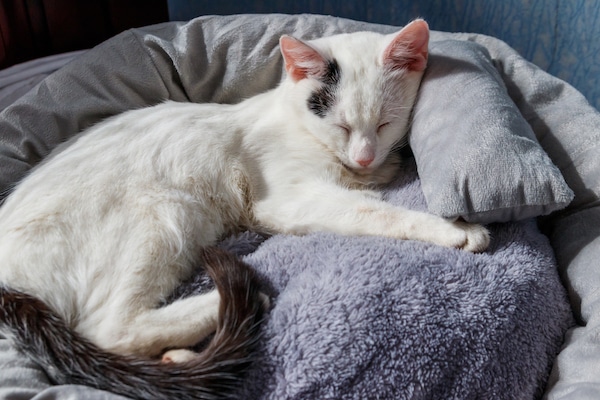
OlyaSolodenko via iStock
How to use a heated cat bad safely
Heated cat beds are designed with thoughtful safety features, but commonsense precautions also go a long way toward keeping your cat safe. Here are some things to keep in mind:
- Follow the manufacturer’s directions carefully: some beds can’t use an extension cord, some warn against putting blankets on top, and others recommend time limits
- When outside, only use heated beds approved for outdoor use
- Always ensure your cat can freely move away from the heated bed if they get uncomfortable or too hot
- Even though most outdoor beds are waterproof/water-resistant, they should still be placed under some kind of shelter (porch, shed, barn, or garage)
- Beds should be checked periodically for signs of wear or damage
- Only use heated beds made specifically for cats: a human heating pad can get too hot, and cat beds include safety features like claw-resistant covers and low wattage
Final Verdict: Can a Heated Cat Bed Help My Chilly Kitty?
We think so! Heated cat beds are effective and generally safe—provided you follow the manufacturer’s guidelines and keep an eye on kittens, chewers, and less-mobile senior cats.
We think a heated bed will work best for:
- Cats who live in cold climates
- Thin or hairless cats
- Outdoor, stray, or feral cats
- Kittens who need additional warmth*
- Senior cats and arthritic cats*
- Cats recovering from surgery or injury*
*These cats can benefit, but require closer supervision
On the other hand, the following cats might do better with an alternative heating method:
- Cats who like to chew
- Cats with mobility issues who might struggle to move away when they get too warm
- Cats who are unsupervised for long periods (heated beds should be checked regularly)
For cats in the latter camp, a cozy sweater or just a traditional, non-heated cat bed may work out better. You can also boost their body temperature by encouraging exercise with a favorite interactive cat toy.
How We Chose
The heated cat beds featured here were selected based on a combination of our own hands-on testing, a deep dive into customer reviews across several retail platforms, and an interview with veterinarian Dr. Debra Eldredge, DVM.
We prioritized heated beds with safety features like chew-resistant cords, temperature-regulating thermostats, and claw-proof covers. Additionally, we considered their practicality of use, looking at washability, portability, and cost. We’re also guided by the experience of living and playing alongside our own much-loved and strongly opinionated cats, who are never stingy with their feedback.
Further Reading
- The 11 Best Heated Cat Beds for Every Kind of Cat and Every Kind of Home
- Review: K&H’s Heated Thermo-Kitty Fashion Splash Bed Leads With Safety and Comfort
- The Best Cave Cat Beds for Your Kitty to Curl Up In
- Snuggler? Sprawler? We’ve Found the Perfect Cat Bed for Your Cat
- The 10 Best Outdoor Cat Houses to Shelter Your Kitties This Winter
- Is My Cat Cold? How to Keep a Cat Warm in Winter
